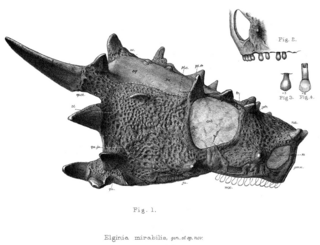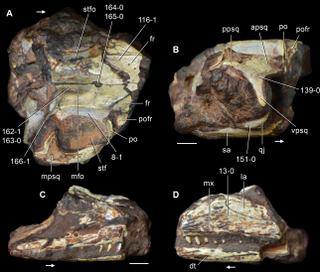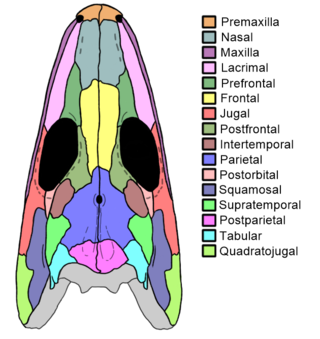
In the human skull, the frontal bone or sincipital bone is a unpaired bone which consists of two portions. These are the vertically oriented squamous part, and the horizontally oriented orbital part, making up the bony part of the forehead, part of the bony orbital cavity holding the eye, and part of the bony part of the nose respectively. The name comes from the Latin word frons.

The jugal is a skull bone found in most reptiles, amphibians and birds. In mammals, the jugal is often called the malar or zygomatic. It is connected to the quadratojugal and maxilla, as well as other bones, which may vary by species.

Elginia is an extinct genus of pareiasaurid known from the Late Permian of Scotland and China. It was named for the area around Elgin in Scotland, which has yielded many fossils referred to as the Elgin Reptiles.
Slaugenhopia is an extinct genus of dvinosaurian temnospondyl within the family Tupilakosauridae. Fossils have been found from the Early Permian San Angelo Formation in Texas. The type and only species, S. texensis, was named in 1962. It may be closely related to the dvinosaur Kourerpeton. Slaugenhopia was once classified as a trimerorhachid but is now classified as a tupilakosaurid.

Aerosaurus is an extinct genus within Varanopidae, a family of non-mammalian synapsids. It lived between 252-299 million years ago during the Early Permian in North America. The name comes from Latin aes (aeris) “copper” and Greek sauros “lizard,” for El Cobre Canyon in northern New Mexico, where the type fossil was found and the site of former copper mines. Aerosaurus was a small to medium-bodied carnivorous synapsid characterized by its recurved teeth, triangular lateral temporal fenestra, and extended teeth row. Two species are recognized: A. greenleeorum (1937) and A. wellesi (1981).
Parvinatator, from Latin, “parvus” little and “natator” swimmer, is an extinct genus of small ichthyopterygian marine reptile that lived during the Early to Middle Triassic. Its fossils have been found in British Columbia, Canada.

Thaisaurus is an extinct genus of ichthyopterygian marine reptile that lived during the Spathian. Fossils have been found in Thailand.

The skull roof or the roofing bones of the skull are a set of bones covering the brain, eyes and nostrils in bony fishes and all land-living vertebrates. The bones are derived from dermal bone and are part of the dermatocranium.

Microleter is an extinct genus of basal procolophonomorph parareptiles which lived in Oklahoma during the Early Permian period. The type and only known species is Microleter mckinzieorum. Microleter is one of several parareptile taxa described from the Richards Spur fissure fills, and can be characterized from its high tooth count, lacrimal/narial contact, short postfrontal, and slit-like temporal emargination edged by the postorbital, jugal, squamosal, and quadratojugal. Contrary to Australothyris, which had a similar phylogenetic position as a basal procolophonomorph, Microleter suggests that early parareptile evolution occurred in Laurasia and that multiple lineages developed openings or emarginations in the temporal region.
Australothyris is an extinct genus of basal procolophonomorph parareptile known from the Middle Permian of Tapinocephalus Assemblage Zone, South Africa. The type and only known species is Australothyris smithi. As the most basal member of Procolophonomorpha, Australothyris helped to contextualize the origin of this major parareptile subgroup. It has been used to support the hypotheses that procolophonomorphs originated in Gondwana and ancestrally possess temporal fenestrae, due to its large and fully enclosed temporal fenestra and South African heritage. It also possessed several unique features, including a high tooth number, long postfrontal, small interpterygoid vacuity, and a specialized interaction between the stapes and quadrate.

Athabascasaurus is an extinct genus of platypterygiine ophthalmosaurid ichthyosaur known from Alberta, Canada.
Dianopachysaurus is an extinct genus of pachypleurosaur known from the lower Middle Triassic of Yunnan Province, southwestern China. It was found in the Middle Triassic Lagerstätte of the Guanling Formation. It was first named by Jun Liu, Olivier Rieppel, Da-Yong Jiang, Jonathan C. Aitchison, Ryosuke Motani, Qi-Yue Zhang, Chang-Yong Zhou and Yuan-Yuan Sun in 2011 and the type species is Dianopachysaurus dingi, thanking a Professor Ding for his help.

Jesairosaurus is an extinct genus of early archosauromorph reptile known from the Illizi Province of Algeria. It is known from a single species, Jesairosaurus lehmani. Although a potential relative of the long-necked tanystropheids, this lightly-built reptile could instead be characterized by its relatively short neck as well as various skull features.
Leninia is an extinct genus of basal ophthalmosaurine ichthyosaur known from the late Early Cretaceous of western Russia. Leninia was first named by Valentin Fischer, Maxim S. Arkhangelsky, Gleb N. Uspensky, Ilya M. Stenshin and Pascal Godefroit in 2013 and the type species is Leninia stellans. It was named for Vladimir Lenin, one of the leaders of the Communist Revolution in Russia, but not directlу: the museum where fossils is housed is located within the Lenin Memorial and Lenin school complex in Ulyanovsk; accordingly, the generic name reflects the geohistorical location of the find.

Palatodonta is an extinct genus of neodiapsid reptile known from the early Middle Triassic of the Netherlands. It was initially described in 2013 as a basal placodontiform closely related to a group of marine reptiles called placodonts, characterized by their crushing teeth and shell-like body armor. Under this interpretation, Palatodonta is transitional between placodonts and less specialized reptiles. Like placodonts, it has a row of large teeth on its palate, but while these teeth are thick and blunt in placodonts, Palatodonta has palatal teeth that are thin and pointed. A 2023 study instead classified it as a sauropterygomorph and the sister taxon to Eusaurosphargis. In other words, it is close to, but not within, Sauropterygia.
Huskerpeton is an extinct genus of recumbirostran from the Early Permian period. They belong to the order Microsauria, which was established in 1863 by Dawson, and was quickly expanded to include many different small taxa. They lived in what is now Nebraska and Kansas. The holotype of Huskerpeton was uncovered at the Eskridge formation in Nebraska, which is part of how it got its name.

Avicranium is a genus of extinct drepanosaur reptile known from the Chinle Formation of the late Triassic. The type species of Avicranium is Avicranium renestoi. "Avicranium" is Latin for "bird cranium", in reference to its unusual bird-like skull, while "renestoi" references Silvio Renesto, a paleontologist known for studies of Italian drepanosaurs.

Kadimakara is an extinct genus of early archosauromorph reptile from the Arcadia Formation of Queensland, Australia. It was seemingly a very close relative of Prolacerta, a carnivorous reptile which possessed a moderately long neck. The generic name Kadimakara references prehistoric creatures from Aboriginal myths which may have been inspired by ice-age megafauna. The specific name K. australiensis relates to the fact that it was found in Australia. Prolacerta and Kadimakara were closely related to the Archosauriformes, a successful group which includes archosaurs such as crocodilians, pterosaurs, and dinosaurs.

The intertemporal bone is a paired cranial bone present in certain sarcopterygians and extinct amphibian-grade tetrapods. It lies in the rear part of the skull, behind the eyes.
The postfrontal is a paired cranial bone found in many tetrapods. It occupies an area of the skull roof between and behind the orbits, lateral to the frontal and parietal bones, and anterior to the postorbital bone.














